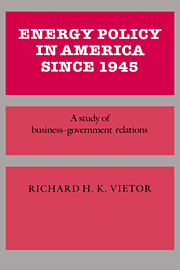Book contents
- Frontmatter
- Contents
- List of charts and figures
- List of tables
- Editors' preface
- Acknowledgments
- List of abbreviations
- 1 Introduction: The political economy of energy
- Part I The transition to peace and fluid fuels, 1945–1958
- Part II Managing surplus through the politics of stasis, 1959–1968
- Part III The second energy transition: adjustment to depletion, 1969–1980
- 9 Energy crisis and structural change
- 10 Equity versus efficiency: oil price controls
- 11 Natural gas: the dilemma of regulatory transition
- 12 Natural gas: the consequences of scarcity
- 13 National energy management
- 14 Business, government, and public policy
- Index
13 - National energy management
Published online by Cambridge University Press: 13 October 2009
- Frontmatter
- Contents
- List of charts and figures
- List of tables
- Editors' preface
- Acknowledgments
- List of abbreviations
- 1 Introduction: The political economy of energy
- Part I The transition to peace and fluid fuels, 1945–1958
- Part II Managing surplus through the politics of stasis, 1959–1968
- Part III The second energy transition: adjustment to depletion, 1969–1980
- 9 Energy crisis and structural change
- 10 Equity versus efficiency: oil price controls
- 11 Natural gas: the dilemma of regulatory transition
- 12 Natural gas: the consequences of scarcity
- 13 National energy management
- 14 Business, government, and public policy
- Index
Summary
Energy crises in the decade of the 1970's strained the balance between market and administrative allocation of energy resources. Shortages, dependence on insecure foreign sources, and startling increases in price convinced the majority of Americans that government should intervene in a comprehensive manner to redirect the behavior of energy producers and consumers. With few exceptions after 1970, politicians, consumers, and business leaders shared a consensus that the United States needed a coherent national energy policy. But there was no agreement on the substance of such a policy. It derived from political choices between supply-stimulus and demand-reduction, direct and indirect allocative mechanisms, and centralized and decentralized organization. Unfortunately, the political process rarely made these choices explicit, nor considered their relationship to market price.
For all the effort spent in formulating a national energy policy, its effects, in the absence of sensible pricing policies, were bound to be marginal. At the time of the first OPEC shock, petroleum and natural gas together accounted for 77 percent of total energy consumption in the United States. Domestic supply of these two fuels, at prevailing administered prices, was the problem. Direct combustion of coal, which accounted for 18 percent of consumption, had some potential as a substitute, but was constrained by its impact on the environment. Nuclear power, with only 1.2 percent of the market, had already begun to stagnate in the face of virulent opposition.
- Type
- Chapter
- Information
- Energy Policy in America since 1945A Study of Business-Government Relations, pp. 313 - 344Publisher: Cambridge University PressPrint publication year: 1984



